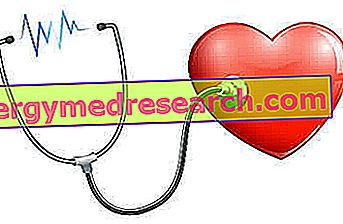Generality
Sinus bradycardia is the decrease in heart rate below the minimum normality limit, set by convention at 60 beats per minute.
This is an arrhythmia - that is an alteration of the normal heart rhythm - which does not involve any irregularity in the beat.
Sinus bradycardia may have a physiological meaning or pathological significance.

Sinus bradycardia following conditions / situations such as: sinus node syndrome, hypothyroidism, hypothermia, anorexia nervosa, etc., is pathological.
For a correct diagnosis of sinus bradycardia it is essential to perform an electrocardiogram.
Treatment of sinus bradycardia depends on the triggering causes.
Brief anatomical and functional recall of the heart
The heart is an unequal organ, formed by a particular muscle - the myocardium - capable of generating and independently conducting the impulses for the contraction of the atria (right atrium and left atrium) and of the ventricles (right ventricle and left ventricle).
The source of these impulses, which are comparable to electrical signals, is found at the level of the right atrium of the heart and is called the atrial sinus node .
The atrial sinus node has the task of marking the right frequency of contraction of the cardiac organ.
When the heart contracts under the action of the atrial sinus, doctors and cardiologists speak of normal heart rhythm or sinus rhythm. The normal heart rhythm of an adult human being has a resting contraction frequency of between 60 and 100 beats per minute.
A cardiac arrhythmia is an alteration of the normal heart rhythm, which can become faster, slower or assume an irregular frequency.

Figure: to achieve the best in its contractile action, the atrial sinus node uses some sorting centers for electrical impulses. These centers are the atrioventricular node, the His bundle and the Purkinje fibers, which together form the so-called electrical conduction system of the heart with the atrial sinus node.
In the electrical conduction system of the heart, the atrial sinus node constitutes the main pedestal center (marker because it scans the heart rate); the atrioventricular node, the His bundle and the Purkinje fibers, on the other hand, represent the secondary marker centers, as they depend on the atrial sinus node.
What is sinus bradycardia?
Sinus bradycardia is a cardiac arrhythmia, characterized solely by a decrease in heart rate below the minimum limit of 60 beats per minute.
Sinus bradycardia, therefore, is an alteration of the heart rhythm without irregularity in the beat.
ANALYSIS OF THE NAME: THE WORDS BRADICARDIA E SINUSALE
The word "bradycardia" derives from the union of two Greek terms, in this case "bradys" (βραδύς), which means "slow", and "cardiá" (καρδιά), which means "heart".
Thus, bradycardia literally means "slow heart".
The word "sinus" refers to the place of origin of the arrhythmia, ie the atrial sinus node.
Causes
Sinus bradycardia can have physiological or pathological significance.
The most common causes of sinus bradycardia of physiological significance are:
- The night's rest .
During the night, the heart of the human being tends to naturally slow down its frequency of contraction, because the requests for blood by some organs and tissues of the body are lower.
- An increase in vagal tone .
It is a classic consequence of sports training. Athletes, especially high-level athletes who practice endurance sports such as cycling, running, swimming, etc., have a heart whose heart rate is slower than normal.
To cite an example, professional cyclists record a heart rate, in the morning immediately after waking up, around 30-35 beats per minute.
The factors that most commonly induce the appearance of a sinus bradycardia of pathological significance are:
- A dysfunction of the atrial sinus node, such as the so-called sinus node syndrome (NB: sinus node is a synonym of atrial sinus node).
Possible causes of dysfunction of the atrial sinus node include: episodes of myocardial ischemia, cardiomyopathies, some congenital anomalies of the heart and the use of drugs such as digoxin, beta-blockers and calcium channel blockers.
According to some medical researches, the sinus node syndrome is the most common pathological cause of sinus bradycardia.
- Hypothermia .
This condition can arise for various reasons; among the most frequent reasons, they deserve a special mention: the prolonged exposure to cold and the abuse of alcohol.
- A condition of hypothyroidism .
- Roemheld syndrome .
It is a condition that induces the appearance of gastrointestinal disorders associated with cardiac disorders.
- An inferior myocardial infarction .
- Anorexia nervosa .
- An electrolytic anomaly, such as hyperkalemia or hypermagnesaemia.
- The increase in intracranial pressure .
- Rhododendron poisoning .
- Some infectious diseases, including diphtheria, rheumatic fever and forms of viral myocarditis .
- Some pharmacological treatments, based on: digitalis, beta-blockers, calcium channel blockers, alpha-2 agonists (clonidine or dexmedetomidine), amiodarone, opiate medicines, barbiturates, benzodiazepines, baclofen or organophosphates.
- The syndrome of obstructive sleep apnea .
Epidemiology
The exact incidence of sinus bradycardia is unknown.
The lack of clarity regarding the number of people with this arrhythmia is due to the fact that, in many cases, the slowing down of the sinus rhythm has a physiological significance, therefore it does not raise any clinical interest.
Symptoms and Complications
Sinus bradycardia in its physiological form is generally devoid of problems. It is for this reason that doctors also define it as "non pathological bradycardia".
The case of sinus bradycardia in its pathological form is different. In fact, this can be responsible for:
- Hypotension
- Dizziness or dizziness
- Syncope
- Dyspnea (or shortness of breath)
- Chest pain
- Intolerance to exercise
- Peripheral edema
- Mild cyanosis
- Reduced peripheral perfusion. It causes pallor, low temperature at the extremity (hands and feet), reduction in diuresis, slight mental confusion, etc.
It should be pointed out that, according to some statistics, a fair number of cases of pathological sinus bradycardia are asymptomatic, ie without symptoms or obvious signs.
OTHER SYMPTOMS
Certain conditions triggering sinus bradycardia can lead to the appearance of additional symptoms and physical signs.
For example, hypothyroidism can also cause: constipation, muscle cramps, increased body weight (due to increased appetite), dry skin, dryness and thinning of the hair and extreme sensitivity to low temperatures.
COMPLICATIONS
In the most serious cases of pathological sinus bradycardia, various complications can occur, including:
- State of shock . It arises due to a worsening of the already reduced peripheral perfusion. It involves an accentuation of pallor, hypothermia, renal insufficiency, hypotension, mental confusion, coma etc.
- Pulmonary edema
- Reduction of the level of consciousness
- Worsening of cyanosis
WHEN TO REFER TO THE DOCTOR
According to experts, the presence of the aforementioned symptoms and pathological signs must induce those affected to contact their doctor immediately or to go to the nearest hospital for diagnostic tests.
Diagnosis
In the path that leads to the identification of a sinus bradycardia of pathological significance, the electrocardiogram is the key examination for a correct and definitive diagnosis.
However, it is good to remember that they are helpful, especially with regards to determining the causes, even the physical examination, the medical history, some laboratory tests and the echocardiogram.
The recognition and precise description of the causes of sinus bradycardia are fundamental for therapeutic purposes, as they allow cardiologists to plan the most appropriate therapy.
IMPORTANCE OF ELECTROCARDIOGRAM
The electrocardiogram reveals the rhythm and electrical activity of a heart, drawing a characteristic trace on graph paper (where each square of 1 millimeter corresponds to 0.04 seconds).
The tracing of the rhythm and electrical activity of a healthy heart has 5 relevant elements, called waves, which repeat themselves with regularity. The waves are identified with the capital letters P, Q, R, S and T.
With the help of the figure below, the reader can appreciate what the arrangement of the waves is and notice how there is a certain distance between them, identified with the term interval .
The length of an interval on the sheet of graph paper indicates the duration of this interval.
 | ||
| Features of a normal ECG | ||
| Event | Duration (in seconds) | Meaning |
| Wave P | 0.07 - 0.12 | Atrial depolarization (ie atrial contraction) |
| QRS complex | 0.08 - 0.11 | Ventricular depolarization (ie ventricular contraction) |
| Wave T | 0.18 - 0.20 | Repolarization of the ventricles (ie relaxation of the ventricles) |
| PR interval | 0.16 - 0.20 | Conduction time of the electric pulse between atria and ventricles |
| ST interval | 0.27 - 0.33 | Time from the end of the depolarization to the beginning of the repolarization of the ventricles |
| QT interval | 0.35 - 0.42 | Time of depolarization and repolarization of the ventricles |
| RR interval | 0.8 - 0.9 | Cardiac cycle duration (is the interval between two PQRST complexes) |
It is important to emphasize that maintaining a certain distance between two waves - therefore the presence of always equal intervals - is an indication of normality in the heartbeat ; vice versa, excessive elongation or shortening of the same distance are synonymous with some alteration.
In this sense, even a change in the appearance of the waves indicates that the heart is functioning abnormally.
Returning to sinus bradycardia, the ECG of a person with such cardiac arrhythmia has the following characteristics:
- P waves with frequency lower than 60 beats per minute.
- RR interval much longer than normal, in terms of squares on the graph paper.
- Slower but regular rhythm.

LAB TEST
Among the laboratory tests that could help to understand the causes of sinus bradycardia are:
- Measurement of electrolytes in the blood
- Quantification of blood glucose levels (blood glucose)
- Measurement of blood calcium levels (serum calcium)
- Measurement of magnesium levels in the blood (magnesium)
- Thyroid function test
Treatment
Sinus bradycardia of physiological significance does not require any kind of treatment, as - as stated - it does not generally represent a problematic situation.
The case of a sinus bradycardia with a pathological meaning is different: in these situations, in fact, the treatment depends on the causes that triggered the arrhythmia and on the characteristics of the latter.
Among the possible therapies, the most widespread are reported, namely: the administration of atropine and the installation of a pacemaker .
THERAPY IN CASE OF BREAST SYNDROME
Treatment of the sinus node syndrome (which is the most common cause of sinus pathological bradycardia) involves the administration of atropine and, in the most serious cases, the installation of a pacemaker.
A pacemaker is a small electronic device, capable of normalizing, through the release of electrical impulses, the cardiac contractions of people with a heart whose rhythm is too slow, too fast, or irregular.
In the specific case of a pathological sinus bradycardia due to sinus node syndrome, the pacemaker serves to regulate a rhythm that is too slow.
SINUS DRUG BRADICARDIA
The treatment of pathological drug-related sinus bradycardia usually involves interrupting the pharmacological treatment that the cardiologist has identified as the triggering cause of the arrhythmia.
The use of atropine and, even more, the installation of a pacemaker is reserved for a few cases.
IN THE PRESENCE OF COMPLICATIONS
In some situations, the complications of sinus bradycardia (obviously pathological) could make it necessary to resort to endotracheal intubation and to use a temporary external pacemaker ("transcutaneous pacing ").
SINUS HYPOTHERMAL BRADICARDIA
In the case of sinus bradycardia due to hypothermia, the most appropriate treatment usually consists in heating the subject affected by the arrhythmia.
Rarely, it also involves the administration of atropine or the installation of a pacemaker.
BRADICARDIA SINUSALE BY HYPOTHRODISM
The treatment of a sinus bradycardia due to hypothyroidism involves the administration of drugs against the triggering morbid condition (therefore against the functional deficiencies of the thyroid gland).
The drugs for hypothyroidism are synthetic hormones such as levothyroxine and liothyronine .
Prognosis
The prognosis in case of physiological sinus bradycardia is generally positive.
In cases of pathological sinus bradycardia, however, the prognosis depends on the underlying causes of the reduction in heart rhythm.
To cite an example, a sinus bradycardia from hypothyroidism can be resolved satisfactorily, provided that the patient correctly takes the drugs against functional deficiencies of the thyroid.
In any case, since pacemakers are available, prognostic predictions in the presence of pathological sinus bradycardia have improved significantly.



